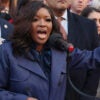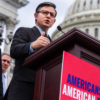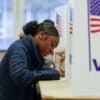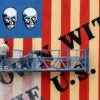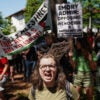“She is a San Francisco liberal.”
That’s how Republican Sen. Tom Cotton of Arkansas—who graduated from Harvard and Harvard Law School—described Vice President Kamala Harris in an interview on CNN last week.
That description of San Francisco may make sense now, but there was a time when it did not.
The Daily Signal depends on the support of readers like you. Donate now
When President Dwight D. Eisenhower boarded his presidential plane—the Columbine III—on Aug. 21, 1956, to go to the Republican National Convention, he did not head for the Midwest or the South. He flew to San Francisco International Airport and then took a limousine to the St. Francis Hotel on Union Square.
The mayor of San Francisco then was George Christopher, a Republican. The venue for that year’s convention was the Cow Palace, an arena that had been built to host rodeos.
That fall, the city of San Francisco voted to reelect Eisenhower over Democratic Illinois Gov. Adlai Stevenson, 51.53% to 48.01%.
What kind of city was San Francisco in that era?
It was a working- and middle-class town. In 1960, according to Census Bureau data posted by the California state government, only 12.2% of San Francisco workers were professional or technical employees. By contrast, more than 71% worked as craftsmen or foreman (9.9%), laborers (4.3%) or operatives (11.5%) or did clerical (23.9%), sales (7.6%), service (11.9%) or household work (2.1%).
That same census showed that 43.7% of the households in San Francisco were families with children under 18.
The median family income in the city was only $6,717—which when converted into June 2024 dollars (using the Bureau of Labor Statistics inflation calculator) equals $71,779.37.
The median value of a home in San Francisco in December 1959 was $17,300—which equals approximately $184,872 in June 2024 dollars.
A majority of workers in the city either worked at home (4.8%) or took a bus or streetcar (36.7%) or walked (10.8%) to work.
Only 11.1% of the city’s 25-and-older population in 1960 had attended four or more years of college.
How did that San Francisco differ from the one populated by the liberals that Cotton derides today?
The new San Francisco is a much wealthier town.
The median household income in the city in 2022, according to the Census Bureau, was $136,692—or $144,695 in June 2024 dollars.
That is more than twice the $71,779.37 median family income (in 2024 dollars) that San Franciscans had in 1960.
In 2022, according to the Census Bureau, 75.8% of the housing units in San Francisco were valued at $1 million or more.
But only 35.3% of the households in the city in 2022 were married-couple families.
Among the city’s workforce in 2022, 12.9% worked for the local, state, or federal government, and 10.9% worked for not-for-profit organizations, while 66.8% worked for private companies.
Among the private-sector workers, only a total of about 22% worked in construction (3.2%), manufacturing (4.7%), wholesale trade (1.4%), retail trade (7.8%), and transportation, warehousing and utilities (4.8%).
By contrast, approximately 62% worked in information (6.0%), finance, insurance and real estate (8.7%), professional, scientific, and management and administrative and waste management services (26.9%), and education services, and health care and social assistance (20.8%).
In 2022, 61.4% of San Francisco adults had a bachelor’s degree or higher. That is more than five times the 11.1% of 1960 San Franciscans who had attended four or more years of college.
In the 2020 presidential election, former Vice President Joe Biden won 85.26% of the popular vote in San Francisco and then-President Donald Trump won 12.72%.
The working-class San Francisco of the 1950s voted for a Republican president. The college-educated, six-figure-income San Francisco of the 2020s voted for a Democrat.
Which is the party of the elite?
COPYRIGHT 2024 CREATORS.COM
We publish a variety of perspectives. Nothing written here is to be construed as representing the views of The Daily Signal.

















